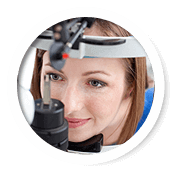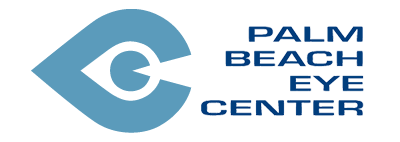Myopia (Nearsightedness)
 Nearsighted individuals typically have problems seeing well at a distance and are forced to wear glasses or contact lenses. The nearsighted eye is usually longer than a normal eye, and its cornea may also be steeper. Therefore, when light passes through the cornea and lens, it is focused in front of the retina. This will make distant images appear blurred.
Nearsighted individuals typically have problems seeing well at a distance and are forced to wear glasses or contact lenses. The nearsighted eye is usually longer than a normal eye, and its cornea may also be steeper. Therefore, when light passes through the cornea and lens, it is focused in front of the retina. This will make distant images appear blurred.
Treatment Options
There are several refractive surgery solutions available to correct nearly all levels of nearsightedness.
Hyperopia (Farsightedness)
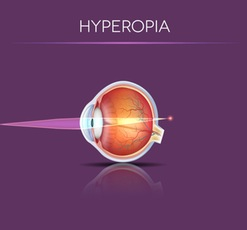 Farsighted individuals typically develop problems reading up close before the age of 40. The farsighted eye is usually slightly shorter than a normal eye and may have a flatter cornea. Thus, the light of distant objects focuses behind the retina unless the natural lens can compensate fully. Near objects require even greater focusing power to be seen clearly and therefore, blur more easily.
Farsighted individuals typically develop problems reading up close before the age of 40. The farsighted eye is usually slightly shorter than a normal eye and may have a flatter cornea. Thus, the light of distant objects focuses behind the retina unless the natural lens can compensate fully. Near objects require even greater focusing power to be seen clearly and therefore, blur more easily.
Treatment Options
LASIK, Refractive Lens Exchange and Contact lenses are a few of the options available to correct farsightedness.
Astigmatism
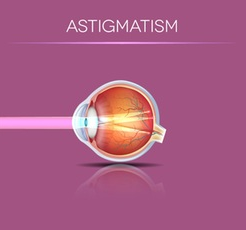 Asymmetric steepening of the cornea or natural lens causes light to be focused unevenly, which is the main optical problem in astigmatism. To individuals with uncorrected astigmatism, images may look blurry or shadowed. Astigmatism can accompany any form of refractive error and is very common.
Asymmetric steepening of the cornea or natural lens causes light to be focused unevenly, which is the main optical problem in astigmatism. To individuals with uncorrected astigmatism, images may look blurry or shadowed. Astigmatism can accompany any form of refractive error and is very common.
Treatment Options
Astigmatism can be corrected with glasses, contact lenses, corneal relaxing incisions, laser vision correction, and special implant lenses.
Presbyopia
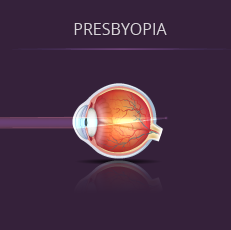 Presbyopia is a condition that typically becomes noticeable for most people around age 45. In children and young adults, the lens inside the eye can easily focus on distant and near objects. With age, the lens loses its ability to focus adequately.
Presbyopia is a condition that typically becomes noticeable for most people around age 45. In children and young adults, the lens inside the eye can easily focus on distant and near objects. With age, the lens loses its ability to focus adequately.
Treatment Options
Although presbyopia is not completely understood, it is thought that the lens and its supporting structures lose the ability to make the lens longer during close vision effort. To compensate, affected individuals usually find that holding reading material further away makes the image clearer. Ultimately, aids such as reading glasses are typically needed by the mid-forties.
Besides glasses, presbyopia can be dealt with in a number of ways. Options include: monovision and multifocal contact lenses, monovision laser vision correction, and new presbyopia correcting implant lenses.
Understanding Refractive Errors
Refractive errors develop when the shape of your eye disrupts how light focuses on the retina. As a result, your vision may appear blurry, distorted, or unfocused. Common types include myopia (nearsightedness), hyperopia (farsightedness), astigmatism (irregular curvature), and presbyopia (age-related near vision decline).
Your Options: Glasses, Contacts, or LASIK
Glasses and contact lenses are trusted and effective tools for correcting refractive errors. They’re non-invasive, affordable, and tailored to your exact prescription. For many, they’re the first line of defense against visual discomfort.
LASIK, however, offers a long-term solution for many patients. Standard LASIK reshapes the cornea, improving focus, while custom LASIK adjusts for minor corneal irregularities, offering sharper and more precise vision correction. Both options depend heavily on the current shape and health of your cornea.
Aging, Vision, and Eye Health
 As you age, your eye’s natural lens loses flexibility, especially noticeable when you hit your 40s and beyond. This condition—presbyopia—makes close-up tasks like reading more difficult. Night vision may also decline, making driving in low light challenging. While natural reversal isn’t possible, corrective options like bifocal lenses or surgical alternatives can help manage the change.
As you age, your eye’s natural lens loses flexibility, especially noticeable when you hit your 40s and beyond. This condition—presbyopia—makes close-up tasks like reading more difficult. Night vision may also decline, making driving in low light challenging. While natural reversal isn’t possible, corrective options like bifocal lenses or surgical alternatives can help manage the change.
Eye Exams: Staying Ahead of Vision Changes
Your eyes can change gradually, and catching those shifts early is crucial. If you already have a refractive error, you should schedule an eye exam every one to two years. These exams not only update your prescription but can also detect early signs of more serious eye conditions.
FAQ: Your Refractive Error Questions Answered
Do refractive errors get worse over time?
Yes, especially during childhood and teenage years. In adults, progression can continue gradually, particularly with age-related presbyopia.
Is LASIK a permanent solution for refractive errors?
LASIK typically offers permanent vision correction, but age-related changes or other eye conditions may still affect your vision later in life.
How often should I get an eye exam if I have a refractive error?
You should get an exam every one to two years to monitor changes and update your prescription if needed.
Do blue light glasses help with eye strain from refractive errors?
Blue light glasses can reduce digital eye fatigue, but they don’t treat or correct refractive errors themselves.
Can presbyopia be reversed naturally?
No, presbyopia is a natural part of aging and cannot be reversed. However, it can be managed with glasses, contacts, or surgery.
How does aging affect refractive errors?
Aging often brings presbyopia and worsened night vision. These changes are common and manageable with the right care.
How do refractive errors affect night vision?
Blurry or distorted night vision is a common side effect, especially if your prescription isn’t up-to-date.
How does corneal shape affect vision correction?
The shape of your cornea determines how well light focuses on your retina and directly impacts the success of glasses, contacts, and LASIK.
Let Dr. Khouri Help You See Clearly Again
You don’t have to live with blurry or strained vision. Whether you’re adjusting to new vision changes or considering LASIK for lasting results, Dr. Khouri in Palm Beach is here to guide you through your best options. Book your comprehensive eye exam today and take the next step toward better vision.







